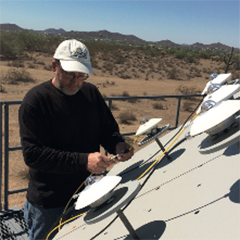Driven by the accuracy requirements of the solar renewable energy industry, solar radiation measurement reaches the next level. Sensor technology is improving, user access to calibration is getting easier, practices for instrument maintenance and measurement uncertainty evaluation are now being standardised. Hukseflux Thermal Sensors, a technology leader in this field, is actively involved.
The weakest link
Until now, measurement of solar radiation has often been often the weakest link in PV system performance assessment. The equipment used for this, pyranometers, is an optical instrument. Their measurement uncertainty under perfect conditions is in the 2 to 3 % range. However, conditions at a solar power plant are frequently imperfect.
A major error source is instrument fouling, for example by dew, frost, rain or dirt. The frequency of pyranometer maintenance is often low. To reduce the impact of fouling, cleaning is essential, but it may not be part of the standard maintenance program.
Recalibration, the most common way of verifying the true performance of the instrument, may only happen from time to time. The overall result of this lack of cleaning and calibration is a much larger measurement uncertainty than that under perfect conditions; typically no better than 5 %.



























